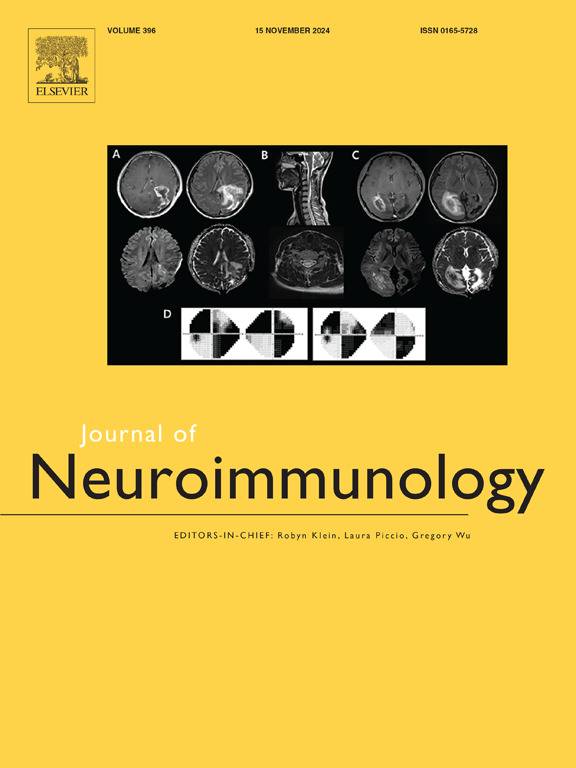视网膜层变薄作为中枢神经系统脱髓鞘疾病的预测因子:来自一项长达十年的队列研究的见解
IF 2.5
4区 医学
Q3 IMMUNOLOGY
引用次数: 0
摘要
背景:中枢神经系统(CNS)脱髓鞘疾病的诊断和鉴别对于及时治疗至关重要,但由于无创、实时评估中枢神经系统结构的方法有限而受到挑战。本研究比较了中枢神经系统脱髓鞘疾病患者和一般人群的视网膜层,并评估了这些结构在前瞻性诊断中的预测价值。方法这项英国生物银行研究,结合光学相干断层扫描图像,分析了在招募和随访期间发现的中枢神经系统脱髓鞘疾病患者。横断面上,基线视网膜结构进行比较,并与交叉验证后构建的诊断模型进行比较。Cox回归用于评估前瞻性队列中未来诊断的风险。结果共纳入34,230例,其中确诊患者61例。黄斑神经节细胞-内丛状层厚度(mGCIPL;p = 4.91 × 10−10),乳头状视网膜神经纤维层(pRNFL;P = 9.92 × 10−6),患者组非中心黄斑亚区(P值为1.16 × 10−2 ~ 1.18 × 10−10)明显变薄。结合mGCIPL、pRNFL和颞外黄斑厚度的诊断模型的曲线下面积为0.779。随访期间,96例患者新确诊。多变量Cox回归显示,较薄的mGCIPL (HR: 0.960, 95% CI: 0.936 ~ 0.984, p = 0.001)和较薄的鼻外黄斑(HR: 0.990, 95% CI: 0.983 ~ 0.997, p = 0.006)是未来诊断的高风险预测因子。结论视网膜结构可作为中枢神经系统脱髓鞘疾病的无创生物标志物,在鉴别临床前和亚临床患者方面具有前瞻性的诊断价值。本文章由计算机程序翻译,如有差异,请以英文原文为准。
Retinal layer thinning as a predictor of demyelinating diseases of the central nervous system: Insights from a decade-long cohort study
Background
Early diagnosis and differentiation of demyelinating diseases of the central nervous system (CNS) are essential for timely treatment but challenged with the limited availability of non-invasive, real-time methods to assess the architecture of the CNS. This study compared the retinal layers between patients with CNS demyelinating diseases and the general population and evaluated the predictive value of these structures in prospective diagnosis.
Methods
This UK Biobank study, incorporating optical coherence tomography images, analyzed patients with CNS demyelinating diseases identified at recruitment and during follow-up. Cross-sectionally, baseline retinal structures were compared, with diagnostic models constructed following cross-validation. Cox regression was used to assess the risk of future diagnosis in the prospective cohort.
Results
34,230 individuals were included, comprising 61 diagnosed patients. The thickness of the macular ganglion cell-inner plexiform layer (mGCIPL; p = 4.91 × 10−10), papillary retinal nerve fiber layer (pRNFL; p = 9.92 × 10−6), and non-central macular subfields (p value ranging from 1.16 × 10−2 to 1.18 × 10−10) were significantly thinner in the patient group. A diagnostic model incorporating mGCIPL, pRNFL and outer temporal macular thickness achieved the area under the curve of 0.779. During follow-up, 96 patients were newly diagnosed. Multivariable Cox regression revealed thinner mGCIPL (HR: 0.960, 95 % CI: 0.936 to 0.984, p = 0.001) and thinner outer nasal macula (HR: 0.990 95 % CI: 0.983 to 0.997, p = 0.006) as high risk predictors of future diagnosis.
Conclusions
Retinal structure can serve as non-invasive biomarker for CNS demyelinating diseases and has prospective diagnostic value in identifying pre-clinical and sub-clinical patients.
求助全文
通过发布文献求助,成功后即可免费获取论文全文。
去求助
来源期刊

Journal of neuroimmunology
医学-免疫学
CiteScore
6.10
自引率
3.00%
发文量
154
审稿时长
37 days
期刊介绍:
The Journal of Neuroimmunology affords a forum for the publication of works applying immunologic methodology to the furtherance of the neurological sciences. Studies on all branches of the neurosciences, particularly fundamental and applied neurobiology, neurology, neuropathology, neurochemistry, neurovirology, neuroendocrinology, neuromuscular research, neuropharmacology and psychology, which involve either immunologic methodology (e.g. immunocytochemistry) or fundamental immunology (e.g. antibody and lymphocyte assays), are considered for publication.
 求助内容:
求助内容: 应助结果提醒方式:
应助结果提醒方式:


